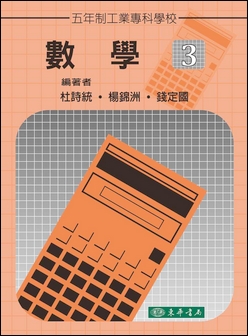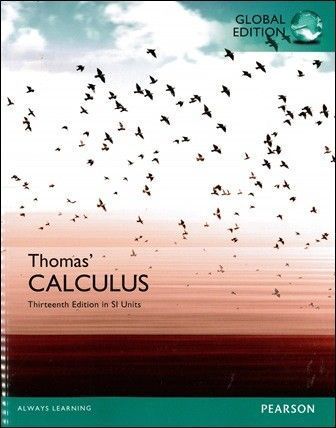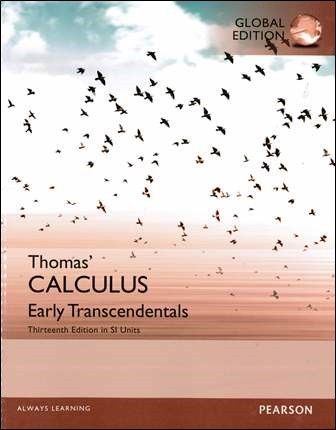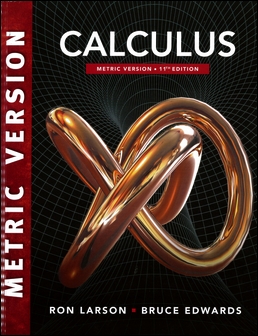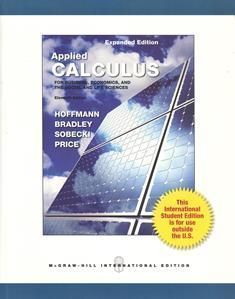書籍分類
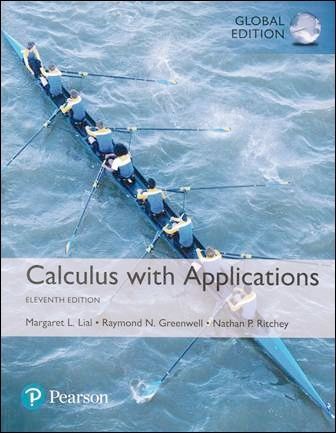
Calculus with Applications 11/e
作者:Margaret L. Lial, Raymond N. Greenwell, Nathan P. Ritchey
原價:NT$ 1,300
ISBN:9781292108971
版次:11
年份:2017
出版商:Pearson Education
頁數/規格:872頁/平裝彩色
參考網頁:Calculus with Applications 11/e
版次:11
年份:2017
出版商:Pearson Education
頁數/規格:872頁/平裝彩色
參考網頁:Calculus with Applications 11/e
內容介紹 本書特色 目錄
- Description
Calculus with Applications, Eleventh Edition by Lial, Greenwell, and Ritchey, is our most applied text to date, making the math relevant and accessible for students of business, life science, and social sciences. Current applications, many using real data, are incorporated in numerous forms throughout the book, preparing students for success in their professional careers. With this edition, students will find new ways to help them learn the material, such as Warm-Up Exercises and added “help text” within examples.
- Features
-
A wide variety of applications reference real data from articles in newspapers, journals, and websites. Examples and exercises with recent data help students learn how the mathematics is applied to their field of study, immediately addressing the question, “Why are we learning this?” NEW! The authors have added or updated 157 (15.9%) of the application exercises throughout the text..
- Apply It opens most sections with a provocative, real-world oriented question that is addressed in the exposition and exercises.
- Applied exercises are grouped by type of application and highlighted for easy identification.
- Extended Applications appear at the end of all chapters to stimulate student interest and foster in-depth learning. Directions for Group Projects in the Extended Applications provide an opportunity for cooperative learning.
- Index of Applications provides instructors and students with an overview of the types of applications throughout the book.
- Application exercises within MyMathLab are labeled by type of application.
-
Assessment and remediation features appear at key points to ensure that students keep up with the material, and provide plenty of pointers to help those who fall behind.
- “Your Turn” exercises following selected examples provide students with an easy way to stop and check their understanding of the skill or concept being presented. Answers are provided at the end of the section’s exercises.
- NEW! Warm-Up exercises were added to many exercise sets to provide an opportunity for students to refresh key prerequisite skills at “point of use.” Each exercise includes a note about where students can go for help if needed.
- The Prerequisite Skills Diagnostic Test, just prior to Chapter R, gives students and instructors an opportunity to assess students’ skills on topics that are critical to success in this course. Answers refer to specific review material in the text for targeted remediation.
- An Algebra Referencechapter appears at the beginning of the text, allowing students to brush up on their algebra skills.
- “For Review” boxes in the margin provide immediate review, or refer students back to appropriate sections as needed.
- “Help text” annotations, set in small blue type, appear next to the steps within worked-out examples and provide an additional aid for students with weaker algebra skills. Many more have been added in this edition.
- Chapter Summaries include important concepts, rules, and formulas, helping students review what they have learned.
- Caution notes warn students of common errors/misconceptions and Note boxes offer additional useful information. Both are highlighted for easy reference.
-
Diverse exercise sets show how math is used in students’ major courses of study–business, life science, and social sciences.
- Connection Exercises integrate topics/concepts from different sections. These are denoted with an icon.
- Writing Exercises provide students with an opportunity to write about important mathematical ideas. These are denoted with an icon.
- Technology Exercises, denoted with an icon, explore concepts using a graphing calculator or spreadsheet.
- Concept Check exercises in the Chapter Reviews help students verify their understanding of important topics.
- Reference Tables for Exercises appear in the back of the book. These tables correlate homework exercises to a helpful example in the text.
-
Technology coverage keeps your classroom and students up-to-date with the latest software and technology options available on the market.
- The design makes it easy to identify technology coverage so instructors can more easily highlight (or skip) the material.
- Excel® Spreadsheets are included in examples and exercises where appropriate, allowing students to work problems that closely relate to real-life and business situations.
- Graphing Calculator discussions are included in many examples, but are not essential for understanding the text. NEW! Graphing calculator screens have been updated to reflect the TI-84 Plus C, which features a higher-resolution color screen.
- Technology Notes Material on graphing calculators or Microsoft Excel is clearly labeled to make it easier for instructors to use this material (or not).
-
The MyMathLab® course for this text contains many assignable exercises with help features that can be customized to the needs of your students. NEW! At the request of MyMathLab users, we added more applications to this revision.
- NEW! Setup & Solve exercises require students to specify how to set up a problem, then solve it. These exercises mirror what students will be asked to do on tests.
- Application labels within exercise sets (e.g., “Business/Econ”) make it easy for instructors to find types of applications appropriate to students.
- NEW! An Integrated Review version of the course contains pre-assigned diagnostic and remediation resources for key prerequisite skills. Skills Check Quizzes help diagnose gaps in skills prior to each chapter. MyMathLab then provides personalized help on only those skills that a student has not mastered.
- Personalized Homework functionality allows instructors to create homework assignments based on the results of student assessments.
-
Tutorial videos for every section of the textbook cover important concepts and terms, and are easily accessible for students who miss lecture. NEW! Videos are available as full-length lectures and as shorter, assignable video clips that focus on a specific concept or example.
- NEW! A Guide to Video-Based Assignments shows which exercises correspond to each video clip, making it easy to assess students after they watch an instructional video. This is perfect for flipped-classroom situations.
- NEW! Tutorial videos involving graphing calculators are available to augment existing “by hand” methods, allowing you to tailor the help that students receive to match how you incorporate graphing calculators into the course.
- NEW! Learning Catalytics is a “bring your own device” student engagement, assessment, and classroom intelligence system. Students use any modern web-enabled device they already have. With Learning Catalytics, you assess students in real time, using open-ended tasks to probe student understanding. It allows you to engage students by creating open-ended questions that ask for numerical, algebraic, textual, or graphical responses–or simple multiple-choice. Students who have access to MyMathLab have instant access to Learning Catalytics and can log in using their MyMathLab username and password. Learning Catalytics contains Pearson-created content for calculus that allows you to take advantage of this exciting technology immediately.
- Interactive Figures illustrate key concepts and allow manipulation for use as teaching and learning tools. These include assignable exercises that require use of the figures.
- Added new Your Turn exercises to ensure that there is a student assessment for each major concept.
- Added more detail to R.2 on factoring perfect squares.
- Rewrote the part of 1.1 involving graphing lines, emphasizing different methods for graphing.
- Rewrote 1.2 on supply, demand, break-even analysis, and equilibrium; giving formal definitions that match what students would see in business and economics courses. All of the business applications were revised, according to recommendations of reviewers, to be more in line with business texts. Also added a new Example 6 on finding a cost function.
- Added color for pedagogical reasons to make content easier to follow.
- Updated introduction to 2.1, rewriting it as an example to make it easier for students to reference the necessary skills to identify nonlinear functions, determine the domain and range, and estimate values from a graph.
- In 2.2, added another approach to graphing parabolas by splitting former Example 4 into two separate examples. The new Example 5 illustrates how to graph a parabola by first finding its characteristics (including orientation, intercepts, vertex, and axis of symmetry). The characteristics are highlighted in a box for easy reference.
- Added quadratic regression to 2.2. Example 9 includes a by-hand method and a method using technology.
- Rewrote Example 10 in 2.2, which illustrates translations and reflections of a graph, by breaking it into three parts. The first part is a basic transformation, and the ensuing parts build in complexity.
- Added the definition of a real root to 2.3 and added a technology box to illustrate how to use a graphing calculator to approximate the roots of higher degree polynomials.
- Added cubic regression to 2.3 (Example 5).
- Added Caution note to 3.1 and added a new solution method to Example 9.
- Added new Example 2 to 3.3 using recent data.
- Updated Example 4 in 3.3 to use clearer wording.
- Clarified the rules for differentiation in 4.1, 4.2, 4.3 and added a new Example 8.
- Expanded Example 9 in 4.1 to include a new graph.
- Updated Example 10 in 4.1 and Example 4 in 4.5.
- Added new examples to 5.2 (Example 3c) and 5.3 (Example 6b).
- Expanded Example 6a in 5.4 to show the inflection point.
- Updated Example 3 in 6.1 to show an application of the concept.
- Modified examples in 6.2 (Example 3), 6.4 (Example 2), and 6.6 (Example 1).
- Added annotations and comments to Example 10 in 7.1.
- Simplified Examples 1, 2, 3, and 6 in 7.2 and added annotations and comments.
- Added a “For Review” box to 7.3.
- Enlarged all small integral signs throughout the chapter for added clarity.
- Updated Example 7 in 7.4 and Example 5 in 7.5.
- Added more explanation of the consumer surplus to 7.5.
- Added annotations to several examples in 8.1 to denote steps in integration by parts.
- Revised the solutions to Examples 4 and 5 in 8.3, giving more detail and adding annotation to denote the steps in determining the accumulated amount of money flow.
- Rewrote and expanded Exercise 8 in 9.1, on the Cobb-Douglas Production Function, emphasizing the interpretation of the solutions.
- Added 3 new exercises to 9.1 on exponential and logarithmic functions of several variables.
- Revised the solution to Example 4 in 9.3, giving more detail.
- Rewrote the solution to Example 3 in 9.4, illustrating how to find the extrema of a constrained function of one or more variables using a spreadsheet.
- Revised the solution to Example 5 in 10.1, adding annotation to denote steps in separation of variables.
- In 10.1, added the definition of equilibrium point, explained how to determine the stability (stable, unstable, or semistable) of the equilibrium point, and added Example 8 on equilibrium points and stability.
- Changed the introductory example in 11.1, which continues into 11.2, to avoid rounding issues.
- Added a new part (d) to Example 3 in 11.3, as well as Method 2 using a graphing calculator and Method 3 using a spreadsheet.
- Changed 11.3 so that graphing calculators are the primary method of calculating normal probabilities, and the normal table is the secondary method.
- Revised Example 4 Method 1 (Graphing Calculator) in 12.1.
- Added further clarification on the TVM Solver to Example 8 in 12.2.
- In 13.1, revised coverage of translating graphs of sine and cosine functions. Also added a box to highlight the transformation of trigonometric functions.
- Added Example 8 to 13.2, which illustrates how to find the relative extrema for trigonometric functions.
- In 13.2, added new exercises (37—56), which use applications of the derivative applied to trigonometric functions. Applications include: critical numbers, intervals where the function is increasing and decreasing, relative extrema, higher order derivatives, intervals where the functions are concave upward and concave downward, inflection points, detailed graphs, absolute extrema, implicit differentiation, related rates, and differential approximation.
MyMathLab not included. Students, if MyMathLab is a recommended/mandatory component of the course, please ask your instructor for the correct ISBN and course ID. MyMathLab should only be purchased when required by an instructor. Instructors, contact your Pearson representative for more information.
Also available with MyMathLab
MyMathLab is the online homework, tutorial, and assessment program designed for this text to engage students and improve results. Within its structured environment, students learn, practice and apply what they learn, test their understanding, and take advantage of a personalized study plan that adapts to their needs.
New To This Edition
Content Updates
Chapter R
- Table of Contents
R. Algebra Reference
1. Linear Functions
2. Nonlinear Functions
3. The Derivative
4. Calculating the Derivative
5. Graphs and the Derivative
6. Applications of the Derivative
7. Integration
8. Further Techniques and Applications of Integration
9. Multivariable Calculus
10. Differential Equations
11. Probability and Calculus
12. Sequences and Series
13. The Trigonometric Functions
Tables
Table 1 Formulas of Geometry
Table 2 Area Under a Normal Curve
Table 3 Integrals
Table 4 Integrals Involving Trigonometric Functions
Answers to Selected Exercises
Photo Acknowledgements
Index



